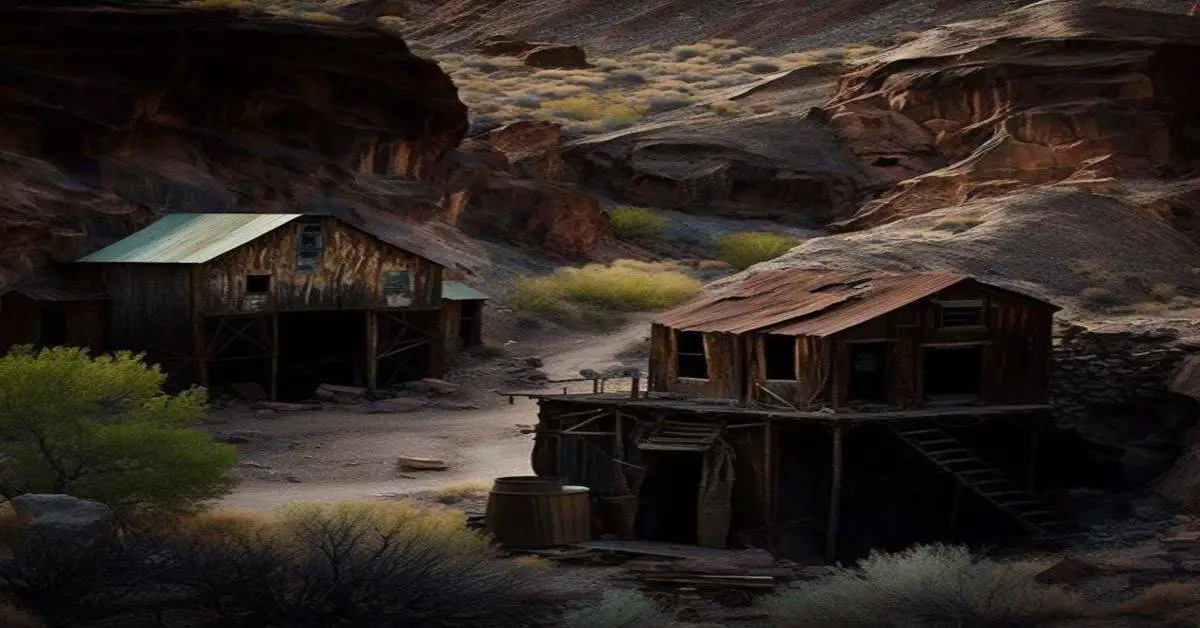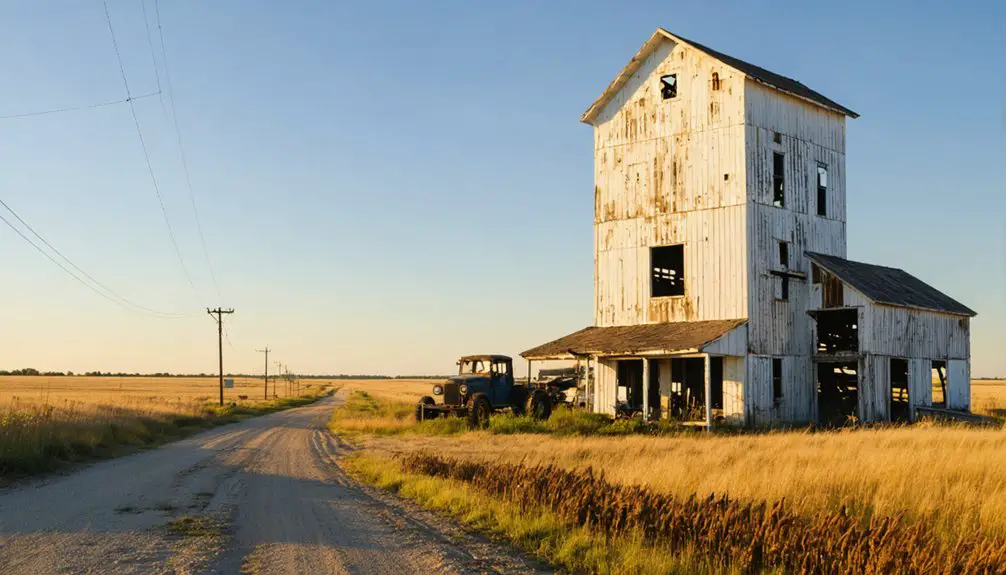You’ll find Lonetree’s ghost town remains along North Dakota’s historic Milwaukee Railroad line, where it was established in 1908. The town once thrived with 342 residents, featuring a general store, timber yard, and schoolhouse that served railway workers and farmers. After its post office closed in 1930, Lonetree gradually declined as diesel engines replaced steam locomotives. Today, five preserved structures, including the “Ghost Cathedral” and customs house, stand as silent witnesses to the town’s railroad heritage.
Key Takeaways
- Lonetree was established in 1908 as a railroad settlement, reaching a peak population of 342 residents before becoming a ghost town.
- The town’s decline began with its post office closure in 1930 and accelerated as diesel engines replaced steam locomotives.
- Current remains include five to six buildings, notably the “Ghost Cathedral” church and customs house, protected by preservation fencing.
- The site features early 20th-century prairie architecture and follows the Great Northern Railway’s standardized town planning principles.
- German and Scandinavian immigrants formed communities near the railway, creating a vital transportation network in North Dakota.
The Rise and Fall of a Railroad Town
When the Milwaukee Railroad expanded its operations in 1908, Lonetree emerged as a strategic railroad settlement in North Dakota. Named after a Milwaukee Railroad official, the town quickly grew to support 67 residents, mostly railway workers living in section houses.
A modest railroad town born of necessity, Lonetree housed railway workers in section houses along North Dakota’s Milwaukee line.
You’d have found a general store, timber yard, and two-room schoolhouse serving the burgeoning community. The Chicago, Milwaukee Railway served as the town’s main connection for agricultural transport and passenger service.
The town’s railroad expansion brought impressive infrastructure, including some of the country’s largest stockyards and multiple grain elevators. Today, visitors can still see the grain processing equipment inside the remaining elevator structure.
But by 1930, signs of agricultural decline appeared when the post office closed. The switch from steam to diesel engines eliminated vital water and coal stops, while modernized farming reduced the need for local shipping.
What Remains Today: A Ghost Town’s Legacy
The haunting remnants of Lonetree stand as silent witnesses to North Dakota’s railroad era, with only five to six buildings marking what was once a bustling community.
Like many towns that peaked before WWII, Lonetree’s decline mirrors the pattern of other North Dakota communities that lost residents to larger centers with modern amenities. Many towns faced this fate as nearby towns became more convenient for residents.
Today, you’ll find a notable old church visible from the road, though it’s posted with “no trespassing” signs, and a former customs house undergoing community preservation efforts.
The town’s historical significance lives on through:
- A small cemetery that reflects the town’s peak population of 342 residents
- The original main road layout with scattered remaining structures
- Ongoing restoration projects, particularly the customs house fundraising initiative
While most buildings are now fenced off, Lonetree’s legacy endures through its physical remnants, cemetery records, and the stories of this once-thriving railroad settlement, offering glimpses into North Dakota’s pioneering past.
Hidden Architectural Gems
Among Lonetree’s weathered structures, you’ll find remarkable examples of early 20th-century prairie architecture that tell deeper stories of North Dakota’s pioneering spirit.
The town’s crown jewel, the “Ghost Cathedral” built around 1910, stands as a symbol of rural ecclesiastical design with its steep gabled roof and lancet windows. The church served as a spiritual center under Rev. Glenn Emmert from 1944 to 1946.
Like many settlements established during the expansion era, the town emerged as one of many railroad towns eight miles apart.
You can explore about five or six remaining buildings along the main square, following the Great Northern Railway’s standardized town planning.
While architectural preservation efforts remain limited due to the harsh climate and remote location, these structures showcase the practical building methods of early settlers who used local wood and stone.
The buildings’ arrangement reflects the typical layout of small railroad towns, with the church serving as both a cultural cornerstone and symbolic reminder of Lonetree’s once-thriving community.
Life Along the Great Northern Railway
During Lonetree’s early years, James J. Hill’s Great Northern Railway transformed the regional landscape, establishing essential railroad communities along its routes.
You’d find construction camps dotting the countryside, where workers lived in bunkhouses and followed strict daily routines to build the infrastructure that would connect remote settlements to major markets. The railway’s special trains carried valuable shipments, including the famous Silk Train that transported cargo between Seattle and Chicago.
The Great Northern Railway’s financial dealings with local railroads led to the Minneapolis Trust foreclosure of the Northern Dakota Railway Company in 1919.
Life along the railway followed a distinctive pattern:
Railway life created predictable rhythms and routines, shaping the daily existence of those who lived beside the iron rails.
- Workers maintained massive water tanks and trestle bridges while section foremen supervised operations from strategic residences.
- Farmers regularly petitioned for new branch lines to ship their crops, often receiving reduced freight rates to encourage settlement.
- German and Scandinavian immigrants established homesteads near the tracks, creating thriving communities connected by passenger service.
These railway settlements formed a crucial transportation network that would shape North Dakota’s development for generations to come.
Exploring North Dakota’s Lost Communities
When North Dakota achieved statehood in 1889, dozens of hopeful settlements dotted the landscape, though many wouldn’t survive the challenges ahead.
You’ll find forgotten histories in places like Sherbrooke, where only two homes and a cemetery remain, or Williamsport, once a proud county seat before the railroad bypassed it.
The Great Depression dealt devastating blows to communities like Arena, while massive infrastructure projects forced others, like Old Sanish and Elbowoods, to relocate as Lake Sakakawea’s waters rose.
Today, these lost communities tell compelling stories through their remnants.
You can explore Lincoln Valley’s abandoned churches and stores, or visit Sims, where community memories live on through tales of the “Gray Lady Ghost” at the still-active church.
Each ghost town reveals how shifting transportation routes and economic forces reshaped North Dakota’s settlement patterns. Once-bustling Omemee exemplifies this decline, falling from 600 peak residents to a ghost town in just a few years.
In the remote corners of the state, places like Nanson stand frozen in time, with no power lines connecting its abandoned homes to the modern world.
Frequently Asked Questions
Are There Any Paranormal or Supernatural Claims Associated With Lonetree?
While you’ll hear whispers of ghost sightings and local legends around North Dakota’s ghost towns, there’s no well-documented paranormal activity specifically tied to Lonetree beyond its haunting “Ghost Cathedral” nickname.
What Happened to the Original Residents After They Left Lonetree?
Most residents of Lonetree moved to nearby larger towns for better jobs and services. You’ll find many relocated to places like Minot or Harvey where they integrated into growing communities.
Can Visitors Take Photographs of the Remaining Buildings?
You’re free to photograph the weathered buildings, but practice respectful photography etiquette while capturing history. Just make certain you’re not trespassing on private land and follow building preservation guidelines for safety.
Does Anyone Maintain the Cemetery or Conduct Genealogical Research Today?
You’ll find limited evidence of formal cemetery maintenance or organized genealogical resources. While state and tribal programs exist for North Dakota cemeteries, there’s no documented regular upkeep or research specific to Lonetree’s cemetery.
What Natural Disasters or Significant Events Impacted Lonetree’s Development?
Like a prairie flower wilting in harsh winds, you’ll find no documented flood damage or specific drought impact, though North Dakota’s brutal winters and the region’s Dust Bowl likely challenged Lonetree’s survival.
References
- https://northernsentry.com/2025/06/26/north-dakota-ghost-towns/
- https://ghostsofnorthdakota892857007.wordpress.com/2017/03/28/the-story-of-how-ghosts-of-north-dakota-began/
- https://writinforthebrand.com/booming-settlement-to-ghost-town-whispers-of-the-living-history-of-charbonneau/
- https://www.youtube.com/watch?v=8GO57Im_dss
- https://usghostadventures.com/haunted-stories/31-days-of-halloween/sophia-and-the-haunted-harvey-library/
- https://en.wikipedia.org/wiki/Midland_Continental_Railroad
- https://www.youtube.com/watch?v=h96KsbNtydo
- https://www.history.nd.gov/archives/manuscripts/inventory/11123.html
- https://www.ndstudies.gov/gr8/content/unit-iii-waves-development-1861-1920/lesson-1-changing-landscapes/topic-6-railroads/section-2-northern-pacific-railway-north-dakota
- https://writinforthebrand.com/the-railroad-and-settlement-in-early-north-dakota/



